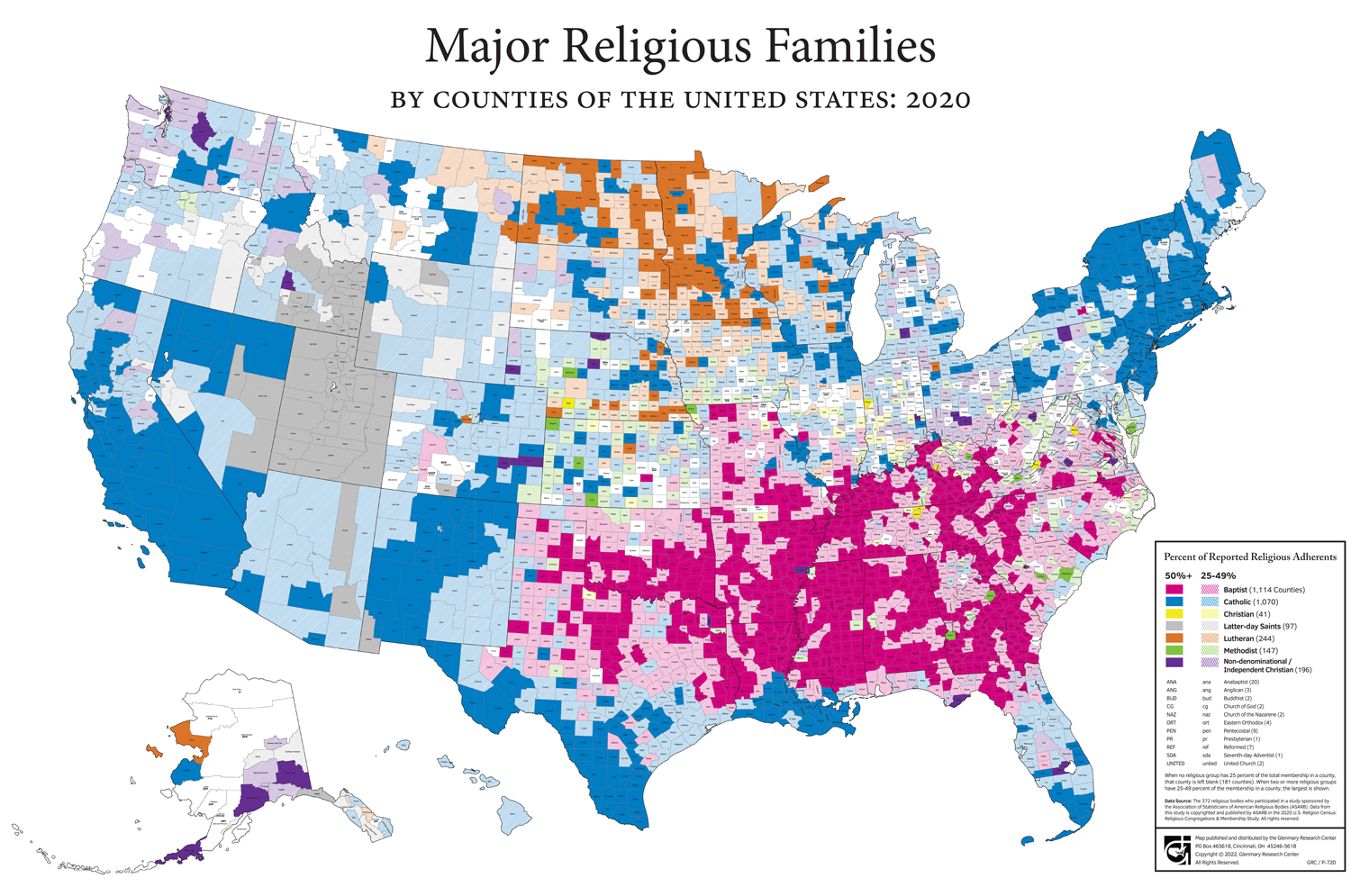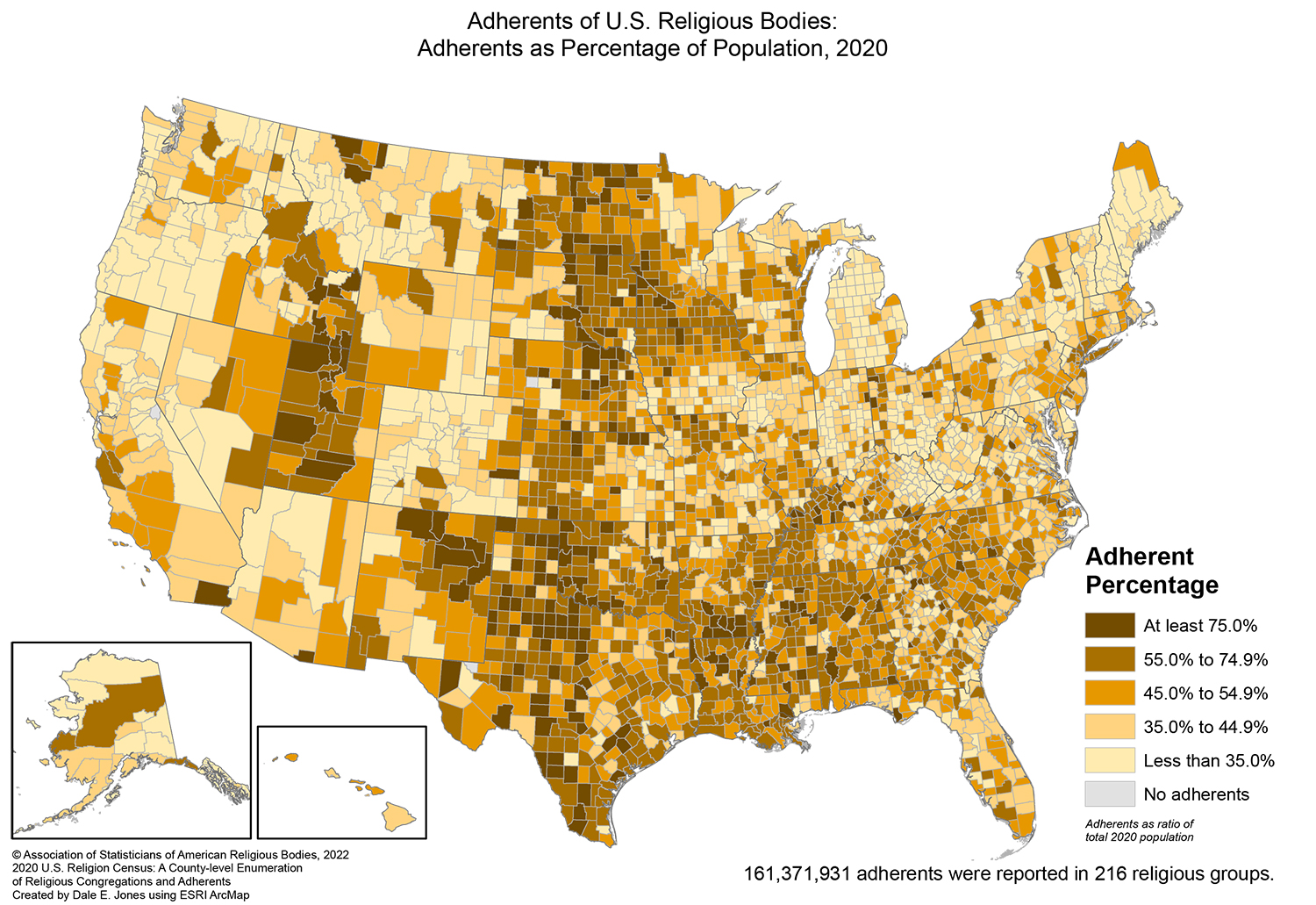(RNS) — A decennial examine of U.S. religious life demonstrates what quite a few demographers and other folks have prolonged identified: Participation in congregational companies has not held up with overall population growth. Nonetheless, religious groups drawing substantial figures of immigrants have seen regular expansion.
The U.S. Faith Census, done each and every 10 years by the Affiliation of Statisticians of American Religious Bodies, concluded there ended up 356,739 spiritual congregations across the country, and 161 million adherents, such as youngsters, in 2020. (Adherents is the method scientists used to rely those with an affiliation to a congregation, together with little ones and people today who attend but may not belong.)
Contrary to polling, which asks concerns from a modest sample of the inhabitants and extrapolates to the standard populace, the religion census gathers details from denominations and other religious bodies and maps out the range of congregations and adherents on a county-extensive foundation. In the 2020 analyze, scientists gathered facts from 372 religious bodies, generally denominations, but also 44,000 independent nondenominational churches. The rely included synagogues, mosques and temples of Jewish, Muslim, Buddhist, Hindu, Sikh and Jain traditions.

Courtesy Chart
The study finds that the Catholic Church in the U.S. is the biggest religious body, with 61 million adherents in much more than 19,000 church buildings, comprising shut to 19{b56f7a0c6479bc075d08fb7619591a4c4023144d1b4aceb7f3fe2776303deb2f} of the U.S. inhabitants. Which is a modest development of 2 million adherents from 2010, when the church had approximately 59 million adherents.
Sociologist who labored on the census stated growth is pretty much solely made up of Hispanic immigrants.
“If you took away the Hispanic inhabitants in the Catholic Church, it would seem as lousy as mainline denominations,” mentioned Scott Thumma, director of the Hartford Institute for Religion Investigation, who counted impartial churches for the census. (Mainline denominations, these types of as Episcopalian, Lutheran and Presbyterian, have been declining for much more than 50 years.)
Associated: Less than half of Us citizens may well be Christian by 2070, according to new projections
Perhaps the most placing advancement was among the Muslims. The amount of Muslims who take part in mosque prayer enhanced from 2.6 million in 2010 to 4.5 million in 2020, a 75{b56f7a0c6479bc075d08fb7619591a4c4023144d1b4aceb7f3fe2776303deb2f} maximize. (Pew Investigate estimates there have been 3.85 million Muslims in the U.S. in 2020, but individuals quantities do not include things like children.)
That growth is because of generally to immigration, reported Ihsan Bagby, affiliate professor of Islamic Scientific tests at the University of Kentucky, who gathered the facts for Muslims. Higher delivery charges may perhaps be a secondary cause.
Bagby estimated the number of U.S. mosques at 2,771, a leap of 871 mosques in just a decade.
He advised Muslims may well be in a variety of golden age in the U.S. They are younger than the American inhabitants overall, and the Boomers amid them are monetarily properly off and ready to lead to the design of new mosques. (First-generation mosques have been usually in retrofitted churches or warehouses.)
Mosques, Bagby said, “have mellowed and matured and grow to be a lot more moderate in their being familiar with of Islam and that has also been an attraction,” he explained. “Many Muslims who experienced held absent come to feel additional comfy coming.”

Courtesy Chart
U.S. mosques, like these overseas, do not normally continue to keep memberships. Bagby reported he arrived at his estimates by asking for information and facts on weekly Jumah prayers as effectively as holiday break or Eid prayers. (Muslims make up about 2.8{b56f7a0c6479bc075d08fb7619591a4c4023144d1b4aceb7f3fe2776303deb2f} of all spiritual adherents and about 1.3{b56f7a0c6479bc075d08fb7619591a4c4023144d1b4aceb7f3fe2776303deb2f} of the full inhabitants, the study estimates.)
Considerably of the value of the census is its county-stage aggregation, which corresponds to how researchers in other fields, such as populace experiments and general public overall health, accumulate and review information, explained Wealthy Houseal, secretary-treasurer of the sociological team that performed the examine.
Houseal explained the data is also beneficial to companies, too. Walmart, he mentioned, has contacted him to assistance determine what textbooks to inventory in their retailers dependent on the dominant spiritual group in a county.
Amid other interesting info factors in the research:
- Southern Baptists have the most church buildings of any spiritual group: 51,379.
- There are some 44,319 nondenominational church buildings, a leap of just about 9,000 over 10 decades in the past, and about 9 million adherents. Nonetheless, overall, they account for only 13{b56f7a0c6479bc075d08fb7619591a4c4023144d1b4aceb7f3fe2776303deb2f} of the full amount of religious adherents in the U.S.
- Southern Baptists and United Methodists every single missing 2 million members from 2010 to 2020.
“Denominational models have weakened, and divisions have increased around issues these kinds of as female clergy or sexual orientation, Thumma explained. “This probably led some adherents to search for or even get started new nondenominational church buildings.”
(In advance of the Pattern is a collaborative effort and hard work concerning Faith Information Support and the Association of Religion Details Archives manufactured possible through the aid of the John Templeton Basis. See other In advance of the Craze articles or blog posts below.)
Related: Millennials adopt digital worship, but not at the expenditure of IRL faith
